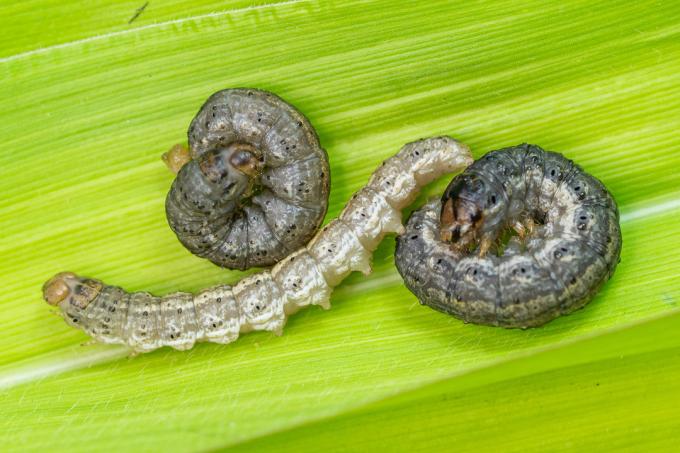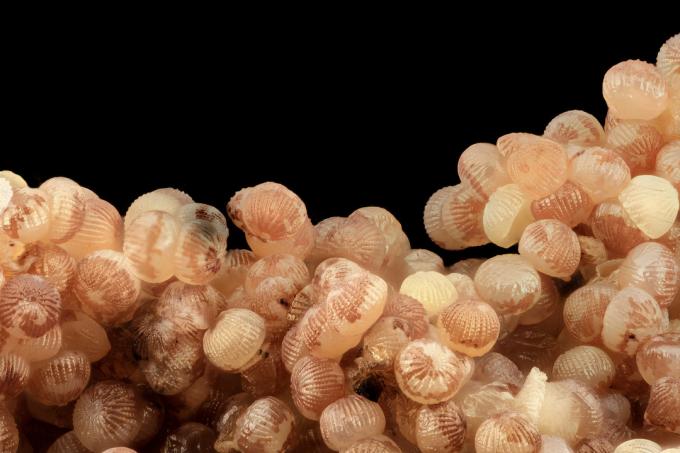Groundworms develop into owl butterflies that swarm at night and are important for our nature. In the garden, however, they can cause damage by eating roots and tubers.

Groundworms, of course, have their raison d'etre. In the garden, however, they mainly appear as pests that can cause trouble in the vegetable patch. In the following, you will find out how you can reliably determine an infestation with groundworms and how to combat the hidden groundworms in a natural and gentle way.
contents
- What are groundworms?
- Identify groundworms: damage and appearance
-
Fight groundworms
- Nematodes against earthworms
- Home remedies for groundworms
- Can you prevent an infestation?
What are groundworms?
Groundworms are the larvae of various owl butterflies of the genera Agrotis, Scotia, Noctua and Euxoa or - depending on the definition - all species of the Noctuidae family. The larvae initially live above ground and then migrate into the ground, where they feed on the roots of many useful plants. At night, some species come to the surface and also feed on parts of plants above ground. If the caterpillars are disturbed, they roll up in a spiral.
Groundworms begin their life cycle on parts of the plant above ground, where female owls lay their eggs. It takes four to seven days for the first larvae to hatch from the eggs. The caterpillars are so small at first that they can easily be overlooked. Depending on the temperature, the larva takes one to two weeks to develop into a larger caterpillar - it is now in the third stage of its development and has already molted two times. From now on it begins to feed on plants in the ground during the day and above ground at night. Finally, in the last larval stage, it migrates over 50 cm into the ground and hibernates there. Pupation takes place next spring just below the surface of the earth in a shiny, nut-brown cocoon.

Note: Groundworms eat potatoes, carrots, lettuce, celery, beetroot, cabbage, spinach, onions, leeks, Maize, various tender young plants, but also ornamental plants and even spruce, larch and the lawn amicable.
Identify groundworms: damage and appearance
The moths of the owl caterpillars look different depending on the species. The wingspan is about 4 cm and the wings themselves are colored in inconspicuous shades of brown and gray. Depending on the weather, the moths fly from late May to late July. Sometimes, however, owl caterpillars still fly in August and September when development is severely delayed.

The eggs of the owl caterpillars are initially white and later black. They are deposited on plants or on the ground. Hatching takes place one to two weeks after the butterfly flight.
The young caterpillars of the owl butterflies are small and hardly visible. They have inconspicuous, earth-colored skin with a green tinge and are hairless. In addition, they leave behind rather inconspicuous, small damage caused by eating (window, hole and leaf edge damage) that are often not noticed at all.

tip: If the earthworms live under the lawn, this shows up in the form of sickle-shaped feeding tunnels that run flat under the surface of the soil. Birds appear as secondary damage and, depending on the location and the fencing in the garden, sometimes even badgers and wild boars, which dig in the ground for the delicious caterpillars.

The pupae of the owl moth lie just below the surface of the earth and are smooth, shiny, and maroon brown. At the back the doll is pointed. When touched, it becomes noticeable that the doll can move.

tip: Specific pheromone traps are a reliable method of detection. They are hung up at the time of the mating flight to determine when owl caterpillars can be expected.
Fight groundworms
Groundworms are found in any healthy garden. If there are too many, however, the garden suffers from them. If you find three to six larvae per square meter in the soil, that already means noticeable damage. Anyone who discovers 30 caterpillars per square meter is expected to be deflated.
For the control of groundworms, almost no pesticides are allowed in the home garden. This is mainly due to the fact that the caterpillars hide so well and are difficult to reach by sprays. Fortunately, there are other effective ways to get rid of groundworms.

Nematodes against earthworms
An effective and ecological method of combating groundworms is the use of nematodes of the species Steinernema carpocapsae. These parasitize the caterpillars hidden in the ground and kill them by releasing a toxin. The roundworms Steinernema carpocapsae you can use our Plantura SC nematodes in your garden. The nematode solution can be used on the lawn and also against the larvae of Mole crickets (Gryllotalpa gryllotalpa) as Wiesenschnaken (Tipula paludosa) insert. Once spread in the ground, the roundworms lie in wait for their future hosts. Then they attack the groundworms and kill them with the help of bacteria without affecting other gardeners.
Application of our SC nematodes against earthworms:
- The optimal time for use against groundworms is between June and September.
- The contents of the supplied bag are stirred into the appropriate amount of water according to the instructions for use.
- The suspension is poured into a watering can and spread over the floor area to be treated. It should be stirred again from time to time so that the nematodes do not settle on the bottom of the watering can.
- After application, you should water the treated area with about one liter of water per square meter to flush the nematodes into the soil. In the following two weeks, too, it is important to ensure uniform moisture in the soil so that the roundworms find optimal living conditions.
Further application information can be found in the detailed instruction leaflet.
Tip: Another very effective remedy against owl caterpillars, which are still feeding on the plant above ground, are bacteria of the species Bacillus thuringiensis. Although these may only be used on cabbage against owl caterpillars, they not only fight owl caterpillars there, but also caterpillars of the cabbage white butterfly. This is the type of bacteria that ours works with Plantura organic borer-free XenTari® reliable against groundworms on cabbage.
Home remedies for groundworms
There are a number of home remedies that can also be used to combat:
- The development of the earthworms in the soil is disturbed by tillage. So chopping before sowing is useful if you expect a heavy stock of earthworms.
- Covering the vegetables with culture protection nets prevents the owl butterflies from laying their eggs. With a little luck, the butterfly will look for a place where its larvae cause less damage.

Tip: There is also the possibility of luring the caterpillars of the owl butterflies with special bait: mix water and sugar and bran in a wide bowl to form a rather firm pulp and dig the bowl flush with the ground near the plant. You can later collect the earthworms from the bowl.
Can you prevent an infestation?
There is no one hundred percent protection against groundworms, as there are different types of owl butterflies in Germany that like to lay their eggs on crops. The best way, however, is to create a natural garden and a varied crop rotation. Natural enemies of earthworms are birds, shrews, hedgehogs, moles, ground beetles and parasitic wasps. Who these animals for example with a Flower meadow, a wild corner in the garden or a hedge with native trees, can also regulate the earthworms.
And something else helps against the voracious animals: Groundworms don't like moist soil. Anyone who mulches the vegetable patch and even ensures moisture under the mulch through drip irrigation will drive away owl caterpillars for a long time.

Owls are butterflies, even if they only fly at night. the most popular native butterfly species we present to you in our special article.



